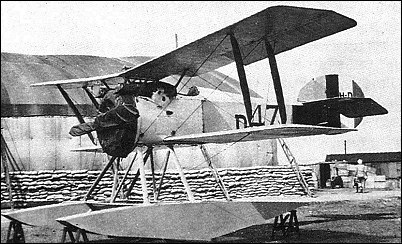|
| At the end of 1917, a derivative of the HD.1 intended for
use by France's Aviation maritime as a single-seat
fighter floatplane was tested as the HD.2. Possessing
an airframe essentially similar to that of the HD.1, the
HD.2 was powered by a 130hp Clerget 9B rotary engine
and carried an armament of twin synchronised Vickers
machine guns. Two prototypes were tested with float
undercarriages of differing lengths, and several HD.2s
with wheel undercarriages were delivered to the
Aviation maritime at Dunkirk for trials purposes. These
included operations from a 12m platform
mounted above a turret of the battleship Paris in the
harbour at Toulon. Later, in August and September
1918, similar trials were conducted at Saint-Raphael
with one of the HD.2 prototypes converted to landplane
form and re-engined with a 120hp Le Rhone. Ten HD.2 float fighters were purchased on behalf of the US Navy,
these subsequently being converted to landplanes by
the Naval Aircraft Factory. They were used for training
at Langley Field and one was employed in August 1919
for trials from a platform mounted on the battleship USS
Mississippi.
 | A three-view drawing (800 x 584) |
| MODEL | HD.2 (float-equipped) |
| WEIGHTS |
| Take-off weight | 723 kg | 1594 lb |
| Empty weight | 495 kg | 1091 lb |
| DIMENSIONS |
| Wingspan | 8.70 m | 29 ft 7 in |
| Length | 7.00 m | 23 ft 12 in |
| Height | 3.10 m | 10 ft 2 in |
| Wing area | 18.20 m2 | 195.90 sq ft |
| PERFORMANCE |
| Max. speed | 183 km/h | 114 mph |
| Ceiling | 4800 m | 15750 ft |
| Range | 300 km | 186 miles |
| Chris Hoehn, e-mail, 22.05.2009 09:18 Bill, the answer is yes and no. The 2 seater is almost certainly a Sopwith 1-1 /2 Strutter(the US Navy acquired a couple of dozen after the war.) Hanriot got his start building warplanes by subcontracting the construction of Sopwith 1-1 /2 Strutters and Pups. When he developed his own fighter design, the HD-1 he borrowed much for the Sopwith designs; the family resemblence is unmistakeable.
During WWI the Royal Navy was looking for a means of providing fighter protection from high flying Zeppelins which were scouting for the German Navy. Utilizing Sopwith Pups and Camels, the British experimented with barges towed by destroyers and platforms built atop the turrets and guns of battleships. They used fighters with standard landing gears rather than pontoons because the added weight and drag of the pontoons prevented the fighters from reaching the necessary altitudes. However, this generally ment these fighters were good for only one flight as there was no means of recovering them once launched and were usually ditched if they were too far from land. The US Navy was sufficently impressed that they equipped The USS Texas (BB-35) with these "fly-off platforms" before returning home at war's end.
The device is your inquiring about is usually called a "hydro-plane", and it was originally developed by the British though not for aircraft carriers but rather for battleships. The purpose was to prevent weight of the aircraft's engine flipping the aircraft while ditching. Though the water landing usually caused enough damage to the aircraft to write it off it did allow for the safe recovery of the pilot. The US Navy improved the ability of thier aircraft to be recovered by adding a pair of inflatable floats extending forward from beneath the wings
out beside the engine.
The Navy eventually equipped all 14" gunned battleships with these platforms and from 1919 through 1921 used Sopwith Camels, Sopwith 1-1 /2 Strutters, Hanriot HD-2's(converted back to land planes) and Nieuport 28's on board these ships. The development of the compressed-air catapult and the more powerful radial engine made floatplanes a more practical for battleship and cruiser operations. While the aircraft carrier proved a better answer to fighter cover for the fleet.
I have seen 1 photo of a "hydro-plane" equipped aircraft landing on the USS Langley. If memory serves it was a Vought VE-7. This may reflect a practical adaptation of the device to one that helped fledling pilots learning to land on the deck of a ship not to destroy thier props or the flight deck.
Chris Hoehn reply | | Bill Schultz, e-mail, 21.08.2007 06:11 By any chance was the HD-2 modified further by the US Navy in adding a second seat(dirctly under the wing), truncating the lower end of the rudder and adding a strut just forward of the landing gear?
This strut seems to be intended to either prevent tipping forward during landing or possibly engaging an arresting wire on a carrier deck.There is no evidence of any type of tailhook. At that stage of carrier aviation they probably had envisioned the hook concept.
I have a phot ofjust such an aircraft that looks for all the world to be a Hanriot HD-2 heavily modified as decribed above.
If in fact such modifications did take place did they redesignate the aircraft?
Any guidance you can provide would be greatly appreciated. Thanks!!!
Bill Schultz
Williamsburg, VA
Mystery Plane editor
Virginia Aeronautical Historical Society reply |
|
Do you have any comments?
|
| 
COMPANY
PROFILE
All the World's Rotorcraft
|







